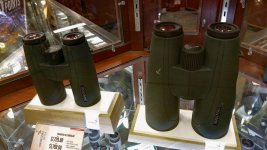etc
Well-known member
You can't really find the new model 8x56 SLC used yet. It just came into the US just lately and there isn't any on the used market yet. It is probably not a huge volume binocular either like an 8x42. I had to pay retail for mine from Eurooptics which was $2150.00. Then once people use them and see how good they are they won't sell them.I haven't seen much price drop on the SF either especially the black model. It is holding firmly in that alpha +$2500.00 range. I did see a LNIB black Zeiss SF 8x42 go for about $1750.00 on Ebay a few months ago. I threw a bid in but was outbid.
Around 1700 would be a sweet deal for the latest generation Zeiss SF.
I think it will get there in a year or two.






